If pinball evokes wistful memories of a youth spent in loud arcades, or that neglected game shedding paint flakes in your uncle’s basement, you may lament the temporal forces that have rendered pinball a unique product of a bygone era. Luckily, you’re wrong: Pinball is alive and thriving and is, in fact, arguably more popular today than at any time in the past two decades.
I’ve trawled through the thousands of pinball machines on the Internet Pinball Database (IPDB) to find 50 of the most special, the coolest, the landmarks in pinball history. This list is highly subjective, of course—after all, the best pinball machine in the world is whichever one you like to play the most. So let’s start at the beginning.
Improvements in Bagatelles (M. Redgrave Bagatelle Co., 1871)
Okay, this one may not be super fun to play. And if you do play it, the guards at the Smithsonian Museum of American History will ask how you got inside the display case. But this little gizmo, which earned patent #115,357 for inventor Montague Redgrave, essentially transformed the parlor game of bagatelle into something that more closely resembled pinball. Redgrave’s innovations included steeply sloping the playfield and launching the ball via a spring-powered plunger rather than the classic billiards cue.
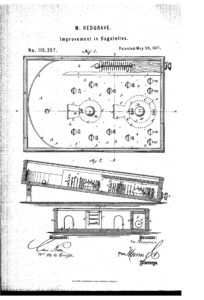
https://www.google.com/patents/US115357
Ballyhoo (Bally Mfg. Corp., 1932)
This squat little gizmo, unassuming by today’s standards, lit the world on fire for pinball. Its affordable price, bright patchwork colors, and catchy slogan (“What’ll they play in ’32? Ball-y-hoo!”) kicked off the Bally Manufacturing Corporation, which—after selling 50,000 of these beauties to bar and arcade owners—would continue to be one of the leading pinball manufacturers for more than half a century. It’s basically Montague Redgrave’s design made commercial, at exactly the time when Americans were looking for seven-balls-for-a-penny entertainment.
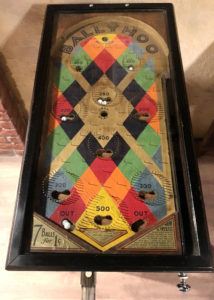
https://www.pinballnews.com/site/wp-content/uploads/sites/terra-technica/09-terra-technica-730×1024.jpg
Big Broadcast (D. Gottlieb & Co., 1933)
Big Broadcast, with its theme of radio towers beaming analog information from such exotic far-flung locales as Detroit, Philadelphia, and Cleveland, holds a special place in pinball history for one reason: It kept score. Nowadays one wouldn’t dream of forcing a player to perform mental math just to come up with a numerical point total, but at the time, a calculator or adding machine (or, as they sometimes called it, a “totalizer”) was an advanced scientific instrument, so most games relied on the nearby human brain to keep score. Big Broadcast, on the other hand, used metal flaps like toilet seats to trap a ball in a given hole and prevent additional balls from falling in as well. With this one-to-one ball-to-hole ratio guaranteed, all that remained was for each ball to roll down a particular metal trough under the playfield and flip a numerical display. It’s like a calculator designed by Rube Goldberg.
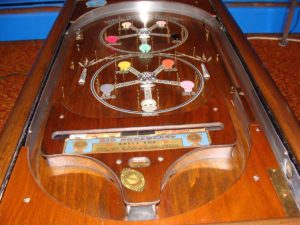
http://www.pinrepair.com/prewar/gtb3301bigbroadcast2.jpg
World’s Fair Jig-Saw (Rock-ola Manufacturing Corp., 1933)
This was about as complicated as a game got in 1933, but even today the feature remains neat. A map of the Chicago World’s Fair of 1933 has been painted onto the underside of a sixteen-piece jigsaw puzzle; rolling the pinballs over the switches flips each puzzle piece into place. Not bad for an invention that predates the ballpoint pen.

http://rockola.buckwerx.com/gallery/js1.png
Humpty Dumpty (D. Gottlieb & Co., 1947)
No list of important pinball machines ever fails to include Humpty Dumpty, so why start now? While it didn’t achieve listicle-topping fame for its theme or artwork (in which Humpty Dumpty, a giant egg with limbs, is somehow popular with bikini-wearing human women—figure that one out, Dr. Ruth), Humpty had something no previous machine did: electromechanical flippers. Or, as the marketing slogan boasted, “Sensationally New Player Controlled Flipper Bumpers”! Granted, the flippers were weirdly positioned, and they didn’t really point at anything helpful, but hey: flippers.

https://i.pinimg.com/736x/43/aa/86/43aa8681925f936da15de3a676c24b18.jpg
Knock Out (D. Gottlieb & Co., 1950)
Knock Out contained the 1950 equivalent of Rock ‘Em Sock ‘Em Robots, a rubber-ringed metal diamond in the middle of the playfield on which two flat, miniature boxers could swing tiny boxing gloves at each other. Or, as its marketing slogan claims, “uproarious slam-bang animation in a real ring on the playfield”! Whether or not the miniscule avatars with moving elbows constituted uproarious slam-bang action, it’s still a pretty cool feature for a machine made otherwise mostly from wood.

http://www.pinrepair.com/gtb/ko4.jpg
Balls-a-Poppin (Bally Mfg. Corp., 1956)
This one deserves a spot on the list for the name alone—not to mention its marketing slogan, “With Riotously Exciting Wild Balls.” But what makes Balls-a-Poppin so ballsy is a prominent kick-out hole labeled, “RELEASE WILD BALLS,” which, when landed in, launched a series of additional balls (as many as nine!) onto the playfield. If one of those landed in the “RELEASE WILD BALLS” hole, the mayhem intensified, augmented all the while by a loud “pop” every time a ball hit a certain type of target—hence the name. It’s also the first machine with flippers to include multiball at all, so imagine how crazily chaotic the whole thing must have seemed in 1956. My balls are a-poppin’ just thinking about it.
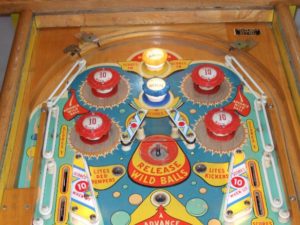
http://affordablepinball.com/yahoo_site_admin/assets/images/2008_0402BallsAPoppin0009.329140652_large.JPG
Bank-a-Ball (D. Gottlieb & Co., 1965)
You know how, when the ball goes to the right or left of the triangle-shaped bumpers, it can either fall down an inlane, feeding it to your flipper, or down an outlane, feeding it to the drain and causing you to curse a lot? Bank-a-Ball, Gottlieb’s billiards-themed game, was the first to include inlanes. That may sound like a historical footnote, but its reviews on the Internet Pinball Database (IPDB) include the word “classic” from so many independent assessments that it has to make this list.

http://antiqueslots.com/images/480_Bank_A_Ball.JPG
Beat Time (Williams Electronics, Inc., 1967)
No copyright infringement here—Beat Time is themed around a totally fictitious musical group, The Bootles, who presumably sing hits like “Can’t Boo Moo Loov” and “Hey Jord.” The gameplay was nothing groundbreaking, but I simply can’t stop staring at the backglass. It’s just so…angular. It’s so…1967.

http://www.pinrescue.com/games/images/beat_time/beat%20time%20003.jpg
Big Flipper (Chicago Coin Machine Mfg. Co., 1970)
Its flippers are big. They are not small. Rather, they are big. And what exactly is the defining feature of these flippers? Specifically, it is their bigness. Also, what part of the game is big? You guessed it: the flippers. And that’s the fascinating story behind Big Flipper, the pinball machine whose flippers are big.

https://pinside.com/pinball/archive/big-flipper/gallery
2001 (D. Gottlieb & Co., 1971)
This game—which, as of this writing, is the top-rated electromechanical machine on IPDB—was also the first to feature multiple banks of drop targets, those plastic rectangles that retreat into the playfield when tapped with the ball. 2001, in fact, set a record of 20 total drop targets, an achievement unmatched before or since. If, you know, drop targets are your thing.
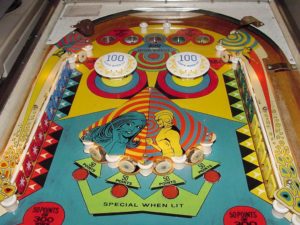
http://www.pinrepair.com/gtb/2001_4.jpg
Surf Champ (D. Gottlieb & Co., 1976)
Surf Champ appears on this list, not because of what it does, but because of what’s been done to it. On the inside, which players typically never see, pinball machines are jumbles of wires, switches, and electrical and mechanical gizmos that are—at least to a certain sort of person—just as beautiful as the machine’s surface. At the Pacific Pinball Museum in Alameda, California, they’ve put the guts of a Surf Champ on full display by replacing the cabinet and playfield with transparent Plexiglas, allowing visitors to marvel at its inner workings. It’s like those clear fish, where you can see their heart and stomach and stuff. You know what I mean? Those are awesome fish. This is better.
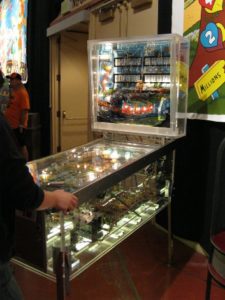
http://1.bp.blogspot.com/-1h0KpgXpxaM/TWHssEk5Z4I/AAAAAAAAA5g/4PPNKz4TNlE/s1600/PPE_VisiblePinball_MichaelScheiss.jpg
Eros One (Fascination Int’l, Inc., 1979)
Gonna go ahead and pick Eros One as the token cocktail pinball table on this list for no particular reason. Cocktail pinballs, which were most popular in the late ‘70s (to the extent that such things could be popular), were kind of like flat octagons on which one could enjoy a highball while chatting up the hot bar patron who presumably didn’t mind you staring at the table.

https://images.pinside.com/f/13/f13e05c174f41d975f99be8cf6478c3fb4959520/resized/largish/f13e05c174f41d975f99be8cf6478c3fb4959520.jpg
Gorgar (Williams Electronics, Inc., 1979)
Nowadays, the idea of a talking pinball machine is essentially a given—a machine’s callouts are part of its sound package, and some games even end up with custom speech recorded by actors from the TV shows or films on which they’re based. But before anyone dreamed of Patrick Stewart in a sound studio saying, “All hands prepare for multiball,” there was Gorgar, the first talking pinball machine. Gorgar could say three nouns (“me,” “you,” and “Gorgar”) and four verbs (“beat,” “hurt,” “got,” and “speaks”), which he could rearrange to form rudimentary sentences. Thus, though he never actually did this, here’s a haiku Gorgar could have said:
Gorgar, you hurt me.
Gorgar speaks: “You? You got hurt?”
Beat me, Gorgar. Beat me.
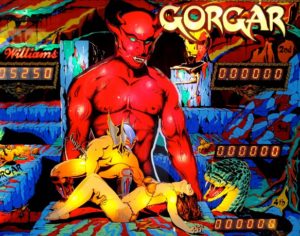
https://i.pinimg.com/originals/ee/44/83/ee4483c4094dc4751f37c3abae49fc6b.jpg
Hercules (Atari, Inc., 1979)
So you’ve been hoping to someday use a pinball cabinet as a coffin, but you’d really like to fit the whole family inside. Good news: Atari’s massive novelty—so large it used an actual billiard ball as a pinball—was big enough to make Zeus himself ask if they might consider taking it down a notch.

https://rockbrat.files.wordpress.com/2013/02/image-4.jpg?w=1400
Black Knight (Williams Electronics, Inc., 1980)
I’m a sucker for multi-level playfields, and on that score, Black Knight was the first of its era. A large section of the playfield is dominated by a sort of “upstairs,” a second wooden playfield with its own flipper and targets, not to mention ramps that rocket the ball back “downstairs.” Black Knight also introduced the sometimes-still-used “Magna-Save,” a magnet under the playfield that a player could activate to magically grab a ball on its way to the outlane. The game was so beloved that Williams made an updated version, Black Knight 2000, in 1989.

http://www.rjbaudio.com/BlackKnight/BKorigPF1.jpg
Firepower (Williams Electronics, Inc., 1980)
One of the top five bestselling games of all time, Firepower was the first solid-state electronic pinball machine to include a now-standard event called multiball. It also introduced the “lane change” feature, which gives the player the ability to switch which lights on the playfield are currently illuminated, thus positioning not-yet-won awards in places the ball is about to travel. That tiny bit of code, which most modern machines have adopted as well, added one more task for the player to focus on while waiting for the ball to return to the flippers—which may sound insignificant, but it helped build pinball into something that requires the player’s undivided attention.
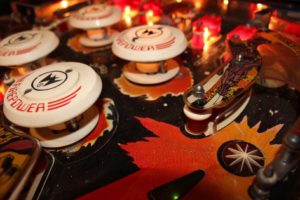
http://www.firepowerpinball.com/
Flight 2000 (Stern Electronics, Inc., 1980)
To pinball enthusiasts, calling a game difficult is a compliment. One might suppose that easy games are more fun to play, and that might be true for a little while. But if you’re the sort of person who’s going to play a pinball machine repeatedly for years—or own one in your basement—you want the game to pose a challenge. Flight 2000, Stern’s first talking game (a year after Williams gave us Gorgar), earns points for having an exceptionally difficult-to-start multiball. Just look at that complicated series of paths in the upper left of the playfield! What cruel monster dreamed up these catacombs and convolutions? You could spend all day trying to start multiball, only to drain all three balls immediately. Such is life. Such is pinball.

http://www.pinballrebel.com/pinball/flight_2000/flight_2000_pinball_2.jpg
Black Hole (D. Gottlieb & Co., 1981)
When you’re walking by a row of pinball machines, Black Hole is the sort of game that stops you in your tracks. Just look at the cool blueness of everything, from the playfield to the pop bumper caps to the subterranean (subspace?) mini playfield that makes you want to be sucked into its void. Black Hole firmly occupies the category of being just unusual enough to be notable without being full-gonzo-bonkers. (If it’s full-gonzo-bonkers you prefer, read on…)

http://1.bp.blogspot.com/-sVhpdaWSTOM/UiQzF1uzzeI/AAAAAAAAHS8/Y-EY5fTmOT4/s1600/Black-Hole-Pinball-Machine8.jpg
Hyperball (Williams Electronics, Inc., 1981)
How could pinball be fun without flippers? Well…what if you could simply fire 250 pinballs across the playfield per minute? Yep, that’d do it. Hence Hyperball, a not-exactly-pinball pinball machine with the letters A through Y displayed around the playfield (Z is reserved for “Z Bombs,” controlled by a special button). Each letter would attack you, or you’d attack it, or you’d spell words, or something. It’s hard to tell what’s going on when you have fifty balls in play at the same time.

http://www.tleaves.com/weblog/images/articles/hyperball.jpg
Orbitor 1 (Stern Electronics, Inc., 1982)
For their hundredth game, Stern Pinball celebrated by manufacturing a machine that would mess with players’ freaking minds. Instead of a flat, wooden playfield, Orbitor 1 used warped, curvy, smooth, backlit, transparent Plexiglas with a misleading moonscape painted underneath it. The effect was that you never knew which way your ball would roll, including back up between the flippers. Go home, Orbitor 1. You’re drunk.
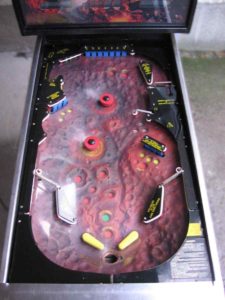
http://pinball.hu/1/pic/orbitor/pf.jpg
Spectrum (Bally Manufacturing Corp., 1982)
Remember that board game Mastermind? Where you had to guess the sequence of colors your opponent had chosen? Sort of? This is kind of like that, only you can’t just “guess” the four-color pattern the computer secretly knows (red-yellow-red-blue, for example). You have to shoot the ball at colored banks of targets in order to guess that color, and if you hit the wrong target by mistake, well, you’ve guessed the wrong color. Also notable is the game’s perfect left-right symmetry—it doesn’t even have a plunger to launch the ball. Instead, somewhat confusingly, the ball springs up from between the flippers.

http://www.pinrepair.com/bally/spectrum3.jpg
Varkon (Williams Electronics, Inc., 1982)
Silly pinball machine. Thinks it’s an arcade cabinet. That’s kind of the idea behind Varkon, a fantasy-themed machine that looks like any other arcade amusement from the era of Dig Dug, BurgerTime, and Donkey Kong, Jr. But peer inside Varkon and you’ll see that the joysticks actually control flippers, and thanks to a cleverly placed mirror, it looks like you’re playing pinball vertically. I mean, you’re vertical yourself, but you were anyway. You know what I mean.
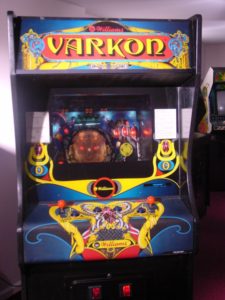
http://www.alsarcade.com/varkon/pics/Front-On-64.jpg
Joust (Williams Electronics, Inc., 1983)
Imagine if flipping the pinball sent it, not up a ramp, but to another person. That’s the premise behind Joust, which wasn’t the only head-to-head pinball machine but may be one of the better-known ones. Remember the Joust video game, with the birds that collided, and the bird with the higher beak was the only one that survived the collision? It was like that, but not.

http://www.pinballnews.com/shows/pinagogo2007/7.jpg
Banzai Run (WMS Industries, Inc., 1988)
Usually the backbox of a pinball machine is a functionless decoration. Sure, some have included weird little mini-games or—nowadays—video animations. But for years, a backbox did little but advertise the name of the game and display your score. On Banzai Run, it’s an entire second playfield, a vertical one. As you can imagine, gravity is less forgiving in vertical pinball, but it’s still really neat to see the ball suddenly enter this mysterious, previously theoretical z-axis.

https://www.pinballzarcade.com/wp-content/uploads/2016/02/banzai_run_pinball-572×1024.jpg
Funhouse (WMS Industries, Inc., 1990)
What’s this on the playfield? Why, it’s a fella. A friendly fella named Rudy who calls players “Bucko” and taunts them when he feels grumpy. Advancing the virtual clock to midnight lulls Rudy to sleep, and when he snores with his mouth open, that’s where you put your balls. Just like that one time in college. Incidentally, Funhouse kicked off a mini-genre of pinball machines containing ball-in-mouth shots, including Stern Pinball’s 2017 game, Guardians of the Galaxy, in which sentient tree Groot is the lucky ball swallower.

https://www.waste.org/~knobs/images/funhouse/rudy003.jpg
Whirlwind (WMS Industries, Inc., 1990)
It’s the pinball machine that blows—literally. With an undesirable-weather-event theme, Whirlwind challenges the player to avoid cyclones, which manifest themselves on the playfield as spinning discs that throw the ball in unanticipated directions. But it’s what’s on top of the backbox that most people remember vividly: a fan. That may not sound like too nifty of a perk—after all, a fan just blows air, and air is free. But when the game cautions “The storm is coming! Return to your homes!”, and then the fan activates and buffets the player with wind, there’s just something beautiful and holistic about the whole experience. Plus, if you’re playing pinball in a hot beach arcade, that fan can feel damn good.

http://firebirdpinball.com/wp-content/uploads/2015/08/Whirlwind1.jpg
The Addams Family (WMS Industries, Inc., 1992)
If you’re unfamiliar with the number of machines one must sell in order to call a game popular, here’s some context. For most titles today, a few thousand is the norm. There are just 41 machines in modern history (based on IPDB sales figures) that have ever sold more than 10,000 copies, and only two have cracked the 20,000 barrier: Eight Ball in 1979 and The Addams Family, which overtopped Eight Ball by selling 20,270 machines, then sold an additional thousand of a higher-quality “Gold Edition” in 1994. Why was The Addams Family so popular? Quite frankly, it happened to have the right confluence of elements: easy to play, hard to master, and it didn’t hurt that it was made in 1992, right at the peak of pinball’s popularity in the early ‘90’s. And it’s impossible not to smile when Raul Julia (as Gomez Addams), backed by an increasing sonic crescendo, announces the beginning of multiball with an exuberant, “IT’S SHOWTIME!”
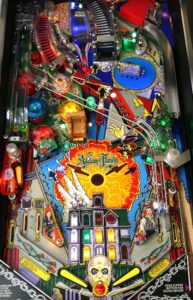
http://kidforcepinball.com/images/playfields/4_large.jpg
Twilight Zone (WMS Industries, Inc., 1993)
For your consideration: After the success of The Addams Family, designer Pat Lawlor was given permission to make his next game even cooler. That game—which required widening the playfield by half a foot just to accommodate its abundance of gadgets, including a pinball-dispensing gumball machine and a mini-playfield with invisible virtual “magna-flippers”—has also become the most “modded” game, as collectors and enthusiasts invent new toys to augment the originals. Also, it’s a hell of a lot of fun.

http://www.northcarolinapinball.com/wp-content/uploads/2013/08/twilight-zone-pinball-playfield-overview.jpg
The Pinball Circus (WMS Industries, Inc., 1994)
One-of-a-kind pinball machines are rare (well, duh), but it’s even rarer to have one publicly playable. And rarer still for one that looks as nifty as the semi-vertical Pinball Circus. I guess what I’m saying is, playing The Pinball Circus at the Pinball Hall of Fame in Las Vegas, where it currently resides, is not just like finding a unicorn—it’s like finding a unicorn you’re allowed to pet for a dollar. (Technically the machine, built as an engineering prototype before WMS rejected the concept, is two-of-a-kind, but the second is in a private collection.) The goal is to use the seven flippers, elephant’s trunk, and giraffe’s neck to send the pinball up to each subsequent level, until at the top level you knock out the clown’s teeth, which actually makes for a somewhat gory circus experience.

Photo supplied with permission from Jay Stafford.
The Who’s Tommy Pinball Wizard (Data East Pinball, Inc., 1994)
It’s inevitable, don’t you think? Tommy, the rock opera and subsequent film that rekindled America’s love of pinball, happens to make a nice subject for a pinball machine itself. Besides the terrific music, this game includes an opaque “blinder” that makes the player feel like the eponymous deaf, dumb, and blind kid—it expands across the flippers, making each flip somewhat of a haphazard guess with no visual feedback. See me, feel me, touch me, play me.

http://www.themeparkreview.com/forum/files/tommy.jpg
Apollo 13 (Sega Pinball, Inc., 1995)
In the you-know-what-measuring contest of whose multiball has the most balls, no game can top Apollo 13. Some games have tried: Aerosmith has a six-ball multiball, Indiana Jones has eight, and let’s not forget the nine in Balls-a-Poppin. Apollo 13 has a throw-everything-at-you 13-ball multiball. Locking balls inside the spaceship rocket triggered this thrilling, somewhat baffling turn of events, as players struggled not to lose six or seven balls in the first five seconds.
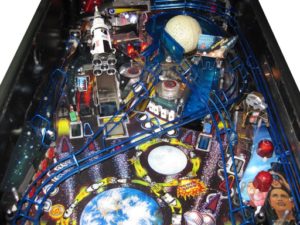
http://www.purcellvillepinball.com/images/Apollo13/a1305.jpg
Attack from Mars (WMS Industries, Inc., 1995)
Pinball players know immediately that someone is a novice if they say, “Ooh, I love that game…what’s it called? Mars Attacks!” Mars Attacks is a sci-fi film released, coincidentally, around the same time as Attack from Mars, and they have nothing to do with each other. Attack from Mars is a simple yet extremely satisfying pinball machine that includes vibrating Martians, secret cow graphics, and multiball mode—only accessible by random award—that involves a strobe light. Just an all-around awesome game that, for many, helped cement the ‘90’s as pinball’s best decade ever.

http://www.robertwinter.com/pinball/restorations/afm/full.jpg
Big Bang Bar (Capcom Coin-Op, Inc., 1996)
In 1996, pinball was enjoying a renaissance, but one which no one knew, or at least no one admitted, had already peaked in 1992. Enter Capcom Coin-Op, a company that existed for the blink of an eye (a year and a half) with the mission of designing and manufacturing original pinball machines. Toward the end of Capcom’s brief foray into pinball, they designed a space-and-alcohol-themed game called Big Bang Bar, made 14 functioning prototypes, then went out of business. That recipe for scarcity has made Big Bang Bar one of the most valuable pinball machines, a title so coveted that a company called Illinois Pinball Inc. licensed Capcom’s design and “remade” Big Bang Bar in 2006-2007, shipping 191 more machines to eager customers. Even today, the remakes still sell for double the price of a new pinball machine.

http://www.flippers.be/images/games/bbb_upperpf.jpg
Safe Cracker (WMS Industries, Inc., 1996)
Unlike the de facto gambling pin machines of the 1930’s, modern pinball machines don’t typically dispense physical prizes. But Safe Cracker, with its mission of raiding a bank vault, gave victorious players a strange little surprise by rolling a commemorative golden or silver token, on its edge, down the glass and pretty much into the player’s crotch. One of the tokens read, “IN PINBALL WE TRUST.”

http://static.tvtropes.org/pmwiki/pub/images/safe-cracker-pinball_1573.jpg
Cirqus Voltaire (WMS Industries, Inc., 1997)
What can I say about Cirqus Voltaire? It’s a creepy, demented circus (so demented as to spell “circus” with a “q”), and the maniacal ringmaster rises from the playfield to such a height that you think he might bust through the glass. (He won’t.) Then there’s a pop bumper that retracts into the playfield! A scoring display on the playfield itself instead of the backglass! Balls automatically “juggled” between three holes! A twisty neon tube! A large plastic ball for some reason! It’s not a game you’ll see in public often, so if you do, drop in a couple quarters and enjoy one of the weirdest—and niftiest—pinball machines in modern history.

https://www.homeleisuredirect.com/Assets/HLD/User/12592-Cirqus-voltaire-pinball-machine-bally-display-home-leisure-direct.jpg
Medieval Madness (WMS Industries, Inc., 1997)
While assembling this list, I worried that perhaps I was overrepresenting games made by WMS in the ‘90’s. Fuck that. Those machines from that decade are awesome, and Medieval Madness is proof. It’s the Middle Ages, and your quest is to lay siege to castles defended by belligerent or drunken knights, rescue damsels, and quash peasant riots. Or…lead peasant riots. I’m not quite sure. It’s also the answer to a recurring piece of pinball trivia: A couple of the distressed damsels were voiced by a little-known Second City actress named Tina Fey.

https://www.homeleisuredirect.com/Assets/HLD/User/18850-williams-medieval-madness-pinball-machine-dragon.jpg
NBA Fastbreak (WMS Industries, Inc., 1997)
In a world where scores have stretched over pinball’s history, from four digits in the 1960’s to ten digits in the ‘90’s, one game dared battle the scourge of score inflation. NBA Fastbreak has basketball-style scoring—two-pointers, three-pointers—making a final score of 150 actually quite good. But NBA Fastbreak’s superpower is its ability to link to a second NBA Fastbreak, activating a mode in which opponents can compete head-to-head. Well, head-near-head.

http://www.pinballnews.com/shows/pinballatthezoo2012/12.jpg
Revenge from Mars (WMS Industries, Inc., 1999)
What a formidable task this machine had. In 1999, the largest manufacturer of pinball machines—WMS, with 70-75% market share—was threatening to exit the pinball business and focus on slot machines. The top brass charged the designers with reinventing pinball for a new generation, or, you know, layoffs. Designers rose to the challenge with this futuristic mashup—a sequel to Attack from Mars—that felt like playing pinball from inside a video game, amazing players who found themselves able to shoot pinballs through a holographic screen of invading Martians. It was innovative, nifty, fun, and profitable. WMS stopped making pinball machines anyway. Stupid capitalism.

http://www.pinballparlour.co.uk/images/tableportrait_revengefrommars.png
The Simpsons Pinball Party (Stern Pinball, Inc., 2003)
Most modern pinball machines have a Wizard Mode, an over-the-top, everything-is-lit frenzy that’s deliberately difficult to earn. The Simpsons Pinball Party takes the concept several steps further with a Super Duper Extreme Wizard Mode (yes, that’s actually what it’s called) so difficult to achieve that only a handful of human beings have ever seen it. Unless, say, they’ve looked for it on YouTube.

http://firebirdpinball.com/wp-content/uploads/2015/01/TSPP3.jpg
Family Guy (Stern Pinball, Inc., 2006)
Family Guy answers the question, “Couldn’t you make a pinball machine with, like, a tiny pinball machine inside it?” In the upper right corner of the game, world domination-obsessed baby Stewie gets a Stewie-sized machine, with tiny ramps, miniature flippers, and a pea-sized pinball. And if the game’s irreverent modes (such as Sperm Attack and Fart Multiball) offend your sensibilities, the same playfield was re-themed as Shrek in 2008, with the tiny pinball belonging to the ogre’s donkey sidekick.

https://www.homeleisuredirect.com/Assets/HLD/User/24745-family-guy-pinball-machine-stewies-mini-pinball.jpg
Pirates of the Caribbean (Stern Pinball, Inc., 2006)
One lesson from the popularity of games like Attack from Mars and Medieval Madness is that players love a big ol’ “bash target,” which is a large, prominent toy to hit repeatedly with the pinball—in these cases, a UFO and a medieval castle, respectively. On Pirates of the Caribbean, the bash target is a nifty pirate ship with sails that collapse when it “sinks.” The game was so popular that, more than a decade later, Stern’s new rival Jersey Jack Pinball announced they would build and sell their own Pirates of the Caribbean, this time incorporating elements from all five films in the franchise. Yo ho ho.

http://www.pinball.center/media/image/PotC_spielfeld.jpg
Bill Paxton Pinball (Ben Heckendorn, 2010)
In 2005, internet celebrity Ben Heckendorn, better known as Ben Heck, decided to build a pinball machine from scratch. It took him until 2010. The amount of time and labor he dedicated, therefore, are especially awesome-slash-hilarious when you consider the theme of the machine in which he invested his efforts: Bill Paxton. The actor. From Twister. And HBO’s Big Love. And…was he in Titanic? Really? Oh, right, he’s the treasure hunter guy who gets the old lady to tell the story. Huh. Neat.

http://www.benheck.com/Games/Pinball/BPP/hero2_large.jpg
Wizard of Oz (Jersey Jack Pinball, Inc., 2013)
For almost 15 years, Stern Pinball had a monopoly. (Appropriately, in 2001, Stern Pinball produced the game Monopoly.) For almost 25 years, all pinball machines had dot matrix displays, making modern games visually indistinguishable from those made during the first Bush administration. Eff that, said “Jersey” Jack Guarnieri, who stuffed his new company’s first machine with a 27” flatscreen in the backbox. Now Dorothy and Toto could look like Dorothy and Toto, rather than looking like a collection of orangish dots.

http://store.jerseyjackpinball.com/core/media/media.nl?id=76455&c=3887496&h=b2e45a045b9aceacb464
Full Throttle (Heighway Pinball, Ltd., 2015)
It’s not the gadgets or the theme that make Full Throttle, new Welsh manufacturer Heighway Pinball’s first creation, so neat. It’s what’s inside: Every major component of the game is plug-and-play. If a flipper breaks on most machines, the repair—called “rebuilding” the flipper—is complicated and involves soldering. On Full Throttle, the flipper unit is self-contained and can be replaced with a new one when necessary. Even the playfield and art can be swapped with other Heighway games, so if you want to own ten different pinball machines, you just need one cabinet and a stack of ten playfields in the closet. (As of this writing, however, Heighway’s second game, Alien, is still in the prototype phase—so you really can’t swap a Full Throttle playfield with anything but your hopes and dreams.)

https://www.videoamusement.com/wp-content/uploads/2016/04/Full-throttle-highway-pinball-cabinet-detail21.jpg
PinBox 3000 (Cardboard Teck Instantute, 2015)
If you’ve ever wanted to make your own pinball machine without spending a million dollars on research and development, behold Cardboard Teck Instantute’s $30, all-cardboard platform for creativity. The only limit is your imagination. And fire. Fire is probably a limit, too—because, um, cardboard.
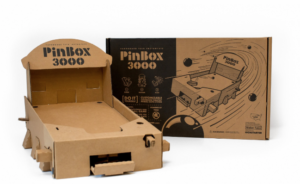
https://cdn.shopify.com/s/files/1/1532/6599/collections/2017-06-04_9.42.10_1400x.png?v=1505345379
Batman (Stern Pinball, Inc., 2016)
Though the game is formally called “Batman” (which might cause one to confuse it with other Batman pinball machines from 1991, 1995, and 2007), this deliberately campy machine—Stern’s first with a video display—is better known as Batman 66, in which “66” refers to 1966, the date of the original biff-pow-kaboom Batman television series. You know, the one with villains like King Tut, Egghead, Shame, and The Bookworm. You…don’t remember them? Most people probably don’t, but it doesn’t matter: Whether you’re battling The Riddler or consulting the gigantic Bat Computer, you’ll feel like you’re in the middle of the 50-year-old series and should probably be wearing tights. Oh, and before multiball begins, Batman says, “Shall we, Robin?”, to which Robin replies, “Let’s, Batman.” Oh, and the game shines the bat signal onto your ceiling!

https://cdn.pastemagazine.com/www/system/images/photo_albums/batman-66-pinball/large/batman66premium-detail-001.jpg?1384968217
The Big Lebowski Pinball (Dutch Pinball, 2016)
Though manufacturing and shipping have experienced delays—to be expected for any newish pinball manufacturer—the few dozen enthusiasts who’ve received their Big Lebowski pinball machines have confirmed that they’re awesome. Every part of the film you know and love is included: making the Dude a white Russian, the rug, the bowling alley, the bowling alley parking lot, and of course, nihilists running with scissors. If you haven’t watched the film, then (a) this game may confuse you, and (b) please go watch the film right now.

http://www.pinball-magazine.com/wp-content/uploads/2014/09/TBL-full-pf-bb-s.jpg
Dialed In! (Jersey Jack Pinball, Inc., 2017)
It’s 2017, for goodness sake, and Dialed In! wants to make sure everyone knows it. Picture this: You’re playing the game, when suddenly it starts to take photos of you and display them on the screen. It’s called Crazy Selfie Mode, and it’s just one of the ridiculously delightful features of a game that also lets you flip the flippers using your own Bluetooth-enabled smartphone. Interactive holograms, drones with spinning propellers, alien attacks that temporarily disable the flippers—it’s a race to save Quantum City from disaster, as well as a perfect demonstration that pinball designers can, and will, continue to innovate.

http://store.jerseyjackpinball.com/core/media/media.nl?id=76447&c=3887496&h=19bbb045584fbc6c8868
Total Nuclear Annihilation (Spooky Pinball, LLC, 2017)
Pinside Forums, a website where fans debate (and sometimes debase) each other’s love of pinball, maintains a list of what its users consider the top pinball machines of all time—and somehow this faux-retro game from fairly recent startup Spooky Pinball has cracked the top twenty. Pinball fans, I’ve found, can be largely split into two camps: those who love the tech-heavy games of the ‘90’s and beyond, and those who love the simpler games of the late ‘70’s and early ‘80’s. Total Nuclear Annihilation satisfies both of them. The game is fast, fun, modern, and immersive—even though it has no ramps or toys. Also, the goal is to disable a melting-down nuclear reactor. Kind of important.

http://www.scottdanesi.com/wp-content/uploads/2017/05/18491530_1433710856690137_8415466169065010846_o.jpg

____________
 Adam Ruben is a writer, comedian, storyteller, and molecular biologist. For over a decade, he has performed at clubs, colleges, and private venues across the country, including at some of the best-known storytelling shows and comedy clubs. He is the author of Surviving Your Stupid, Stupid Decision to Go to Grad School (Random House, 2010), a satirical guide to the low points and, well, lower points of post-baccalaureate education. His new book, Pinball Wizards: Jackpots, Drains, and the Cult of the Silver Ball is out now on Chicago Review Press.
Adam Ruben is a writer, comedian, storyteller, and molecular biologist. For over a decade, he has performed at clubs, colleges, and private venues across the country, including at some of the best-known storytelling shows and comedy clubs. He is the author of Surviving Your Stupid, Stupid Decision to Go to Grad School (Random House, 2010), a satirical guide to the low points and, well, lower points of post-baccalaureate education. His new book, Pinball Wizards: Jackpots, Drains, and the Cult of the Silver Ball is out now on Chicago Review Press.



Hi Adam,
Just wanted to let you know that I had a great time reading your fun article. As a pinhead I enjoyed seeing all my favorites pass, and I especially liked the inclusion of NBA Fastbreak, a machine I own. Not the most popular pinball by any means, but a worthy inclusion because of just the features you mentioned: linked play and keeping score in the 3-digit range instead of the meaningless millions and billions. You actually see the trend reversing with the new Jersey Jack Pinballs, who get to more sensible total scores. I really wanted to mention this, because I have kids in the ages of 7-10, and they love NBA Fastbreak, because the score is meaningful and understandable to them. Although I prefer playing pinball on live machines, I also have a lot of fun playing them on tablet, there is an app called “the Pinball Arcade” which is made by a company who buys up existing machines, takes them apart, digitizes the part, assemble them back to whole in the computer and integrate their own physics engine with the old pinball software to recreate them quite faithfully. Reproducing real physics is very difficult, so it not that near yet to real life to emulate the same experience, but it’s a lot of fun and really good to build knowledge about tables that you don’t have yourself. The reason that I mention this, is that the inclusion in the Pinball Arcade is loosely governed by the same principle for your list: what made that particular table an innovation. Maybe you even used that information yourself in the article, but maybe not. I think you provided a very thorough list, but exclusion of the T2: Terminator machine that was the first commercially produced table with a Dotmatrix Display (“you know, with dots…”) made me wonder that. It’s a nitpick detail that Gilligan’s Island actually was the first table with an DMD, but it got released later. Anyway, thanks for the interesting article!
With regards
Joris van Neijenhof
Hi Joris. Thanks for your comments. I didn’t use the Pinball Arcade for any of this, but it sounds like a great way to learn about rule sets. As for the first with DMD, didn’t Checkpoint predate T2 and Gilligan’s Island? I thought it had the first DMD, though a half-size one.
Best,
Adam
Hey there adam,
while T2 is not the first for a DMD, youre forgetting that T2 is first on a couple of things.
first video mode.
first solid state plunger.
first slingshot mounted “ball cannon”.
im also surprised that ballys “fireball”(1972) isnt on here either. that machine is way ahead of its time, for multiple reasons, spinning disc, superhero/sci-fi theme, movable zipper flippers.
final machine star trek: the next generation.
hidden video mode (rykers poker)
(unless theres a machine before it, that has that)
double slingshot mounted “cannons”
Some of my favorites that should be on a list, my list anyhow:
Cyclone – hurry hurry step right up
Theatre of Magic – you have the magic
Road Show – where’s my pay check
Guardians of the Galaxy – I am grooooot
DeadPool – say it announcer guy
Yes I continue to waste many hours playing these and ones from your list. Thanks for the article.
There are two missing items on your list, which, when you see them, are very, very different… One is a pair of shaker pinball machines and the other is Hi Score pool.
– Spooksville (https://www.ipdb.org/machine.cgi?id=2298) and Sea Hunt (https://www.ipdb.org/machine.cgi?id=2081), with their upright cabinets, flipper buttons at the end of joysticks and the fact that the playfield is inverted because you play while looking at the playfield through a mirror and shaker motors as well.
– Hi Score pool, with it rotary ball shooter (no plunger) and the fact that you don’t see 80% of the playfield.
All the other machines (specially the new batch), are fairly conventional in look and feel (save for some playfield toys), but these machines, boy oh boy, you play them once and you don’t forget them.
The pinball hall of fame in Las Vegas has a Hi Score pool but, sadly, doesn’t have any of the two shaker pinball machines.
So, there, just my 2 cents worth. Other than that, super enjoyable read and a good list overall.
Orbitor 1 was not Stern’s 100th game. I suspect the confusion came in because this game has a “100th Game Special” indicator on the backbox–it’s simply a gimmick feature where a free game is awarded every 100 plays.
Loved the article. But I gotta say, omitting High Speed is like writing a list of important sci-fi movies and skipping Star Wars.
If innovative is key, in 1972-73, Allied Leisure made 2 “Shakerball” games that were upright, played viewing a mirror using two handles that allowed you to shake the playfield to your hearts content. I think that rates them a place in your compilation.
I thought that it made sense that one thing to consider when you need a pinball repair is to contact the manufacturer since each unit is created differently. I have been thinking about buying a pinball machine but I have been worried that it would require complicated repair. I will be sure to reach out to the manufacturer in order to find appropriate help in fixing the machine.
SERIOUSLY?!?!?!
No BABY PAC-MAN ?!?!?
Really enjoyed the article and will keep an eye out for some of these games that I may have just walked past in search of a different game.
That said, I think Theater of Magic is a big omission from the list. The magic trunk in the center of the board that rotates to serve different purposes, including a ball lock, but more importantly a magnet that actually lifts the ball off the board to activate the multiball. I haven’t seen anything like it in any other game (not saying I’ve seen them all). Add into that trapdoors, great game voice interaction with the player (MULTIBALL!), and progressive gameplay challenges that lead to the Grand finale. Theater of Magic is hands down the most entertaining pinball machine I’ve played
Hiya, I am really glad I’ve found this info. Nowadays bloggers publish only about gossips and net and this is really irritating. A good blog with interesting content, this is what I need. Thank you for keeping this web-site, I’ll be visiting it. Do you do newsletters? Can not find it.